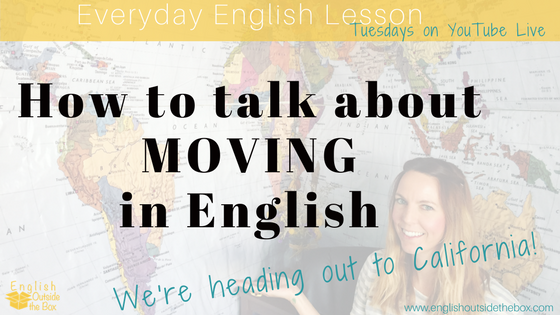
How to talk about Moving in English [naturally]!
I am excited to announce that we’ve officially moved out of our house, and have moved away from the desert! Today’s English lesson is being taught a little closer to my old stomping grounds, and much closer to the beach! We spent this last weekend packing up our house and loading up a moving truck! I cannot believe we managed to pack everything in one truck because it seemed like we had a lot more. We’re moving in to our new house sometime next month and we haven’t settled on what we want to do in between houses.
What do you think we should do? Should we visit a new city? Perhaps we can take a road trip!
I’ll keep you in the loop about what we decided to do, but for now, let’s continue the English lesson we’ve already begun today!
This lesson (and the beginning of my live ‘Everyday English’ lesson today) began with this short story about our moving plans. I wanted to tell you, naturally, about our move and some of the things that we’ve already done. Naturally, you can see 7 phrasal verbs being used, an idiom, 4 different time tenses, the passive AND active tense, modals, and more! This is why I love teaching by using real context, stories, and natural language, because you have the opportunity to hear the real variety that native speakers use.
Don’t worry, we’ll review a lot of this today. In this English lesson, you’ll review:
- 7 phrasal verbs related to moving
- & how to remember to use them
- how different time tenses are used in English within the same context
7 Phrasal Verbs to talk about Moving
move out:
to leave one’s home (apartment, townhome, condo, etc..) in order to go live somewhere else
sounds like: “moo-vowt”
move away:
to leave one’s city for a new place
sounds like: “moo-vuhway”
pack up:
to collect everything together in order to move to another place; to put things into boxes/bags in order to take with you somewhere
sounds like: “pah-kup”
load up:
to fill a car/trunk/something with many items so that it becomes full
sounds like: “low-dup”
pack in:
to put a large quantity of something or a big item into a small space
sounds like: “pah-kin”
move in:
to begin living in a new place (house, apartment, townhome, etc..)
sounds like: “moo-vin”
settle on:
to decide on something; to make a decision
sounds like: “seh-dullon”
Why you Need Different Time Tenses in English
As I was telling my moving story, there were several different things I wanted to express and emphasize. I wanted to talk about how I was currently feeling in the moment (present tense), and actions that happened in the past (past tense). However, I also wanted to focus on actions that were recently completed without a time expression (present perfect tense) and actions with specific times (past tense). Because our moving story was not finished, I also wanted to talk about future plans, and I did this by using the present continuous tense.
By utilizing these different tenses, I was able to express what I wanted to naturally, and easily. This wouldn’t have been possible if I only used the simple present or simple past. So it’s important for you to practice using a variety of tenses in one story so you can emphasize different parts, and bring a little more “life” to what you say.
Practice Makes Perfect
You have phrasal verbs and grammar to review today, as well as pronunciation to sound a bit more natural when you speak.
Before we get into the practice exercises, I want you to think about today’s lesson. How do you feel about the new phrasal verbs? Are you confident that you will be able to understand them a little easier now that you’ve heard them in context, reviewed examples, read the definitions, and “saw” and listened to how they were pronounced?
Today’s lesson was a small review of how I teach more natural English in my monthly training program, The Phrasal Verb Conversation Club.
The Phrasal Verb Conversation Club is a monthly training program that guides you to speak more natural English, and to feel more confident in your ability to learn, remember, and use more phrasal verbs when you speak in English. You can join this training program anytime and get immediate access to the materials!
Each week you’ll receive new materials to help you practice and improve your English. You also be connected with a conversation partner to practice!
- Week 1 introduces at least 10 new phrasal verbs in context so you can hear how they sound, hear how they’re used, and immediately understand the meaning. Week 1 includes audio files, a video, and PDFs with definitions and more practice examples and exercises.
- Week 2 helps you begin using the phrasal verbs in your own life and conversations, by showing you how YOU can apply them to your daily English use. With questions, more context and situations, and the PDFs you can understand the language even deeper so you can remember and use them in your own conversations later.
- This week includes a group conversation call, LIVE, with a native speaker!
- Week 3 is all about pronunciation and helps you say the phrasal verbs more naturally as well as review a common pronunciation principle like word reductions and linking. This week provides you with an audio file to practice with, as well as a video so you can SEE the correct pronunciation and practice more accurately. PDFs will give explanations, details, and over 50 discussion questions to use with your club conversation partner.
- Week 4 wraps up the lesson with a group conversation call, live with me, online to practice speaking, ask questions, review pronunciation, and get more speaking opportunities with the other members and a native speaker.
This training program will not only teach you phrasal verbs and how to use English more fluently and naturally, you will also get more speaking opportunities so that you can start speaking in English at least 4 times per week!
If you’re ready to take the next step and finally start speaking more natural and confident English in your everyday life, then join me and the other members in the conversation club!
To practice today’s material, I want you to think about something you have recently done that has you feeling an emotion today! Follow the structure of my moving story above, and try and write sentences in a variety of time tenses:
- How are you feeling now? Why?
- What have you done recently to cause this feeling? (don’t use specific times)
- Why did you do this action? (use the past simple for specific details)
- How is it going to affect your immediate future?
In order to practice the phrasal verbs, I recommend replaying this video and practicing the pronunciation with me. Listen to the video and repeat what you hear me say. When you’re done write your own sentence examples to read aloud or with your conversation partner.
Can you think of questions to ask me about my move using the new phrasal verbs?
Write your questions in the comments below! You’ll practice using them on your own, and then reading my response!
I hope I see you in the club this month for even more natural English practice and until next time,
Happy Studying! ♥
The Conversation Club will provide you with 6 group conversation calls to practice with a real teacher and a group message community to connect with other members.
You will also get weekly English lessons to help your vocabulary, listening, reading, pronunciation, and more!
Try the Club for 1 week, free! Join the 1-week free trial here.


Id like to link your blog in an assignment for my MA applied linguistics course. Is that ok with you? Your work will not be reproduced and the assignment will only be viewed by the faculty of my school.
I’d like to use a link to your page in an assignment I’m doing for an MA in applied linguistics would that do ok with you? It’s not for commercial use and would only be read by the examiner.
Remember to always give accurate references when citing others’ work: name, website, etc…
Thanks for the great post! Gotta practice!
I’ve been using your lessons to help my students. Context does help a lot. Thanks!